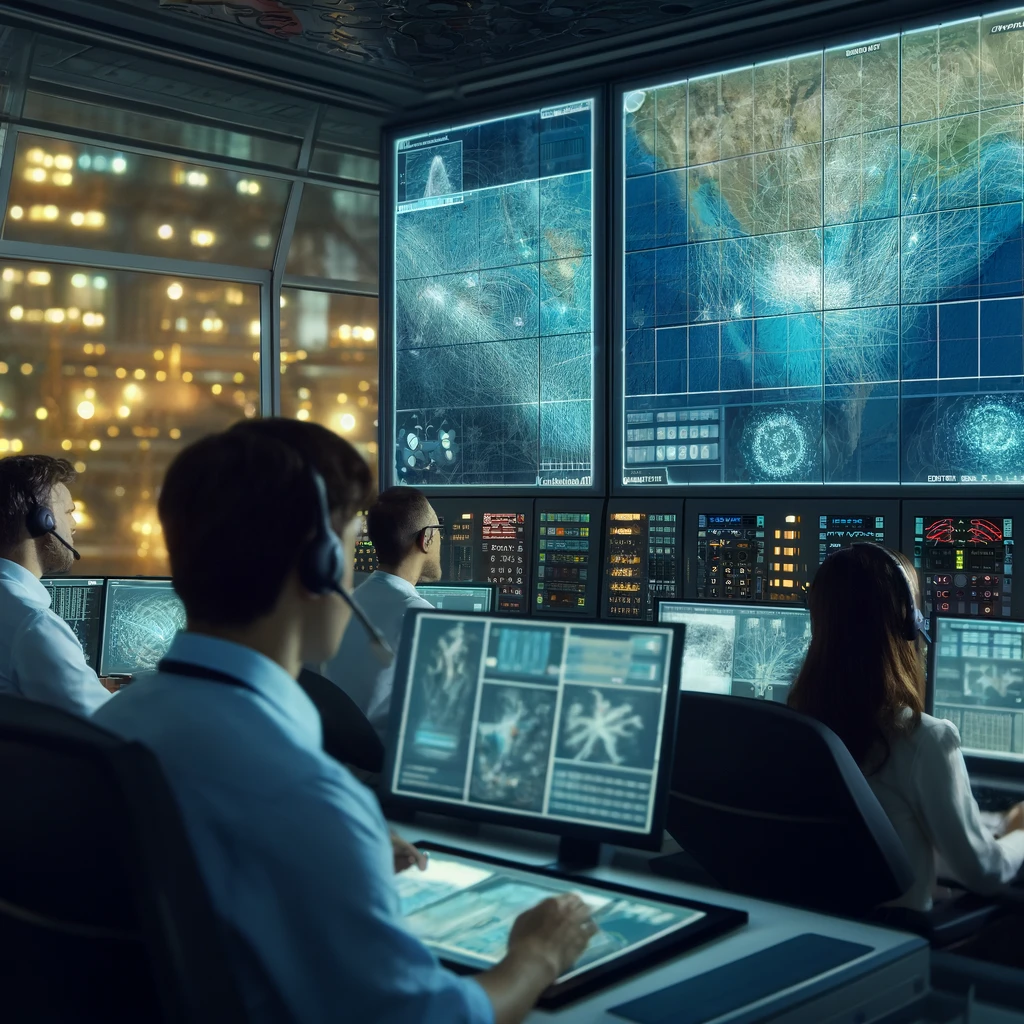A spacecraft named Hera has been launched by the European Space Agency to investigate an asteroid that was intentionally knocked off course by Nasa in 2022. The mission aims to study the effects of Nasa’s collision with the asteroid Dimorphos and assess the potential for preventing dangerous asteroids from impacting Earth. Hera is expected to reach Dimorphos, located approximately seven million miles away, in December 2026. This mission follows Nasa’s Double Asteroid Redirection Test (DART) project, which successfully altered Dimorphos’s trajectory by a few meters.
Dimorphos is a small moon, 160 meters wide, that orbits an asteroid named Didymos in a binary asteroid system near Earth. Nasa’s collision with Dimorphos was a test to determine the feasibility of redirecting asteroids posing a genuine threat to Earth. The Hera spacecraft will examine the impact crater created on Dimorphos, study the asteroid’s composition and mass using cube-shaped probes, and gather information on its physical properties. Understanding these aspects will aid in developing strategies to intercept different sizes and shapes of asteroids in the future.
While the risk of a catastrophic asteroid impact like the one that led to the extinction of dinosaurs is considered low, smaller asteroids can still pose a threat. In 2013, a house-sized asteroid exploded over Chelyabinsk, Russia, causing widespread damage and injuries. Scientists aim to develop systems to detect and divert such asteroids to minimize potential damage. The Hera mission is part of ongoing efforts to enhance our ability to identify and mitigate asteroid hazards, acknowledging that intercepting asteroids requires early detection and precise intervention.
The success of Nasa’s DART project in altering Dimorphos’s course demonstrates the possibility of redirecting asteroids. However, the complexity of identifying and intercepting asteroids before they reach Earth remains a challenge. Scientists emphasize the importance of developing systems to detect and mitigate asteroid threats, highlighting the need for continued research and collaboration in planetary defense. By leveraging advancements in space technology, researchers aim to enhance our ability to safeguard Earth from potential asteroid impacts.
In conclusion, the Hera mission represents a significant step in understanding and addressing asteroid threats to Earth. By studying the impact of Nasa’s collision with Dimorphos, scientists aim to improve our ability to intercept and redirect asteroids that could pose a risk to our planet. While the likelihood of a catastrophic asteroid impact is low, ongoing efforts in planetary defense seek to enhance our preparedness and response capabilities. Through international collaboration and advancements in space technology, researchers strive to minimize the potential impact of asteroids and safeguard our planet.
Original news source: Spacecraft launches towards knocked-off-course asteroid (BBC)
🎧 Listen:
Slow
Normal
Fast
📖 Vocabulary:
| 1 | investigate | To examine or study something in detail to discover more about it |
| 2 | trajectory | The path followed by an object moving through space |
| 3 | feasibility | The practicality or possibility of something being accomplished |
| 4 | composition | The makeup or structure of something |
| 5 | catastrophic | Causing sudden and widespread disaster or damage |
| 6 | mitigate | To make something less severe or harmful |
| 7 | intercept | To stop or catch something before it reaches its destination |
| 8 | collaboration | Working together with others to achieve a common goal |
| 9 | safeguard | To protect something from harm or damage |
| 10 | extinction | The state of being completely destroyed or wiped out |
| 11 | feasibility | The practicality or possibility of something being accomplished |
| 12 | intervention | The act of becoming involved in a situation to change its outcome |
| 13 | planetary | Relating to planets or celestial bodies |
| 14 | advancements | Progress or improvements in technology or knowledge |
| 15 | preparedness | The state of being ready and able to deal with something |
Group or Classroom Activities
Warm-up Activities:
– Word Association
Instructions: Ask students to form a circle and provide them with a keyword from the article, such as “asteroid.” The first student says a word related to the keyword, and the next student has to quickly say another related word. This continues around the circle, and if someone hesitates or repeats a word, they are out. The game continues until only one student remains.
– Keyword Taboo
Instructions: Divide the class into two teams. Choose keywords from the article (e.g., Hera, asteroid, Nasa) and write them on separate cards. One student from each team has to explain the keyword without using the word itself, while their team tries to guess it. Set a time limit for each round, and the team with the most correct guesses wins.
– Opinion Spectrum
Instructions: Select a statement related to the article, such as “Space exploration is essential for the future of humanity.” Have students stand in a line, with one end of the room representing “strongly disagree” and the other end representing “strongly agree.” Ask students to move along the spectrum based on their opinion and encourage them to discuss their reasons with classmates standing nearby.
– Pros and Cons
Instructions: Divide the class into small groups and assign each group a role (e.g., scientists, policymakers, general public). Ask each group to list the pros and cons of asteroid redirection missions like Hera. After a designated time, have each group present their points to the class and facilitate a discussion on the different perspectives.
– Think-Pair-Share
Instructions: Provide a thought-provoking question related to the article, such as “Do you think humanity will be able to prevent a catastrophic asteroid impact in the future?” Ask students to think about their response individually, then pair up with a partner to discuss their ideas. Finally, invite pairs to share their thoughts with the whole class and encourage a group discussion on the topic.
🤔 Comprehension Questions:
1. What is the main objective of the Hera spacecraft launched by the European Space Agency?
2. Why did Nasa intentionally knock an asteroid off course in 2022?
3. What is the composition of the small moon Dimorphos that orbits the asteroid Didymos?
4. How did Nasa’s Double Asteroid Redirection Test (DART) project successfully alter Dimorphos’s trajectory?
5. What event in 2013 highlighted the potential threat of smaller asteroids impacting Earth?
6. Why do scientists emphasize the importance of early detection and precise intervention when it comes to intercepting asteroids?
7. What challenges remain in identifying and intercepting asteroids before they reach Earth despite the success of the DART project?
8. How do researchers aim to enhance Earth’s protection from potential asteroid impacts through international collaboration and advancements in space technology?
Go to answers ⇩
🎧✍️ Listen and Fill in the Gaps:
A spacecraft named Hera has been launched by the European Space Agency to investigate an asteroid that was intentionally knocked off course by Nasa in 2022. The mission aims to study the effects of Nasa’s collision with the asteroid Dimorphos and assess the potential for preventing dangerous asteroids from impacting Earth. Hera is (1)______ to reach Dimorphos, located approximately seven million miles away, in December 2026. This mission (2)______ Nasa’s Double (3)______ Redirection Test (DART) project, which successfully altered Dimorphos’s trajectory by a few meters.
Dimorphos is a small moon, 160 meters wide, that orbits an asteroid named Didymos in a (4)______ asteroid system near Earth. Nasa’s collision with Dimorphos was a test to determine the feasibility of redirecting asteroids posing a genuine threat to (5)______. The Hera (6)______ will examine the (7)______ crater created on Dimorphos, study the asteroid’s composition and mass using cube-shaped probes, and gather information on its physical properties. Understanding these aspects will aid in developing strategies to (8)______ different sizes and shapes of asteroids in the future.
While the risk of a catastrophic asteroid impact like the one that led to the extinction of dinosaurs is considered low, smaller asteroids can still pose a threat. In 2013, a house-sized asteroid exploded over Chelyabinsk, Russia, causing widespread damage and injuries. Scientists aim to develop systems to detect and divert such asteroids to (9)______ potential damage. The Hera (10)______ is part of ongoing efforts to enhance our ability to identify and mitigate asteroid hazards, acknowledging that intercepting asteroids requires early detection and precise intervention.
The (11)______ of Nasa’s DART project in altering Dimorphos’s course demonstrates the possibility of redirecting asteroids. However, the complexity of identifying and intercepting asteroids before they reach Earth remains a challenge. Scientists emphasize the importance of (12)______ systems to detect and mitigate asteroid threats, highlighting the need for continued research and collaboration in planetary defense. By leveraging advancements in space technology, researchers aim to enhance our (13)______ to safeguard Earth from potential asteroid impacts.
In conclusion, the Hera mission represents a significant step in understanding and addressing asteroid threats to Earth. By (14)______ the impact of Nasa’s collision with (15)______, scientists aim to improve our ability to intercept and redirect asteroids that could pose a risk to our planet. While the likelihood of a catastrophic asteroid impact is low, ongoing efforts in planetary defense seek to enhance our preparedness and (16)______ capabilities. Through international collaboration and advancements in space technology, researchers strive to minimize the potential impact of asteroids and safeguard our planet.
Go to answers ⇩
💬 Discussion Questions:
Students can ask a partner these questions, or discuss them as a group.
1. What is your opinion on the idea of intentionally altering the trajectory of an asteroid to prevent it from impacting Earth?
2. How would you feel if you knew that an asteroid was on a collision course with Earth?
3. Do you think it is important for countries to collaborate on projects like the Hera mission to protect Earth from asteroid impacts? Why or why not?
4. What do you think are the potential consequences of an asteroid impact on Earth?
5. Do you believe that space agencies should invest more resources in developing technology to detect and divert asteroids? Why or why not?
6. How do you think the general public can contribute to efforts in planetary defense against asteroids?
7. What role do you think international cooperation plays in addressing global threats like asteroid impacts?
8. Do you think the Hera mission will be successful in providing valuable information to prevent potential asteroid impacts on Earth?
9. How do you think advancements in space technology can help in safeguarding Earth from asteroid impacts in the future?
10. What are your thoughts on the ethical considerations of altering the natural course of asteroids in space?
11. Do you think the Hera mission and similar projects receive enough attention and funding compared to other space exploration missions? Why or why not?
12. How would you react if you found out that an asteroid was discovered to be on a collision course with Earth and there was no current plan to divert it?
13. Do you think public awareness about asteroid threats is sufficient, or should more efforts be made to educate people about this potential danger?
14. What measures do you think individuals and communities can take to prepare for a potential asteroid impact?
15. In your opinion, what are the most important factors to consider when developing strategies to intercept and redirect asteroids that could pose a risk to Earth?
Individual Activities
📖💭 Vocabulary Meanings:
Match each word to its meaning.
Words:
1. investigate
2. trajectory
3. feasibility
4. composition
5. catastrophic
6. mitigate
7. intercept
8. collaboration
9. safeguard
10. extinction
11. feasibility
12. intervention
13. planetary
14. advancements
15. preparedness
Meanings:
(A) Progress or improvements in technology or knowledge
(B) The makeup or structure of something
(C) Working together with others to achieve a common goal
(D) Relating to planets or celestial bodies
(E) To make something less severe or harmful
(F) The state of being ready and able to deal with something
(G) The path followed by an object moving through space
(H) To stop or catch something before it reaches its destination
(I) The practicality or possibility of something being accomplished
(J) The state of being completely destroyed or wiped out
(K) The act of becoming involved in a situation to change its outcome
(L) To protect something from harm or damage
(M) The practicality or possibility of something being accomplished
(N) Causing sudden and widespread disaster or damage
(O) To examine or study something in detail to discover more about it
Go to answers ⇩
🔡 Multiple Choice Questions:
1. What is the purpose of the Hera spacecraft launched by the European Space Agency?
(a) To investigate an asteroid knocked off course by Nasa
(b) To study the effects of climate change on Earth
(c) To explore the surface of Mars
(d) To search for extraterrestrial life on Jupiter
2. When is Hera expected to reach the asteroid Dimorphos?
(a) January 2025
(b) December 2026
(c) March 2023
(d) November 2027
3. What was the name of the asteroid that Nasa intentionally knocked off course in 2022?
(a) Hera
(b) Didymos
(c) Dimorphos
(d) DART
4. What was the purpose of Nasa’s Double Asteroid Redirection Test (DART) project?
(a) To study the composition of an asteroid
(b) To explore the rings of Saturn
(c) To land a rover on Mars
(d) To alter Dimorphos’s trajectory
5. What is Dimorphos?
(a) A small moon orbiting an asteroid
(b) A planet in our solar system
(c) A comet passing by Earth
(d) A star in a distant galaxy
6. What event in 2013 highlighted the potential threat of smaller asteroids?
(a) Hurricane in the Caribbean
(b) Earthquake in Japan
(c) Tsunami in Indonesia
(d) Explosion over Chelyabinsk, Russia
7. What is one of the key aspects the Hera spacecraft will study on Dimorphos?
(a) The atmosphere of the asteroid
(b) The presence of water on the moon
(c) The impact crater created by Nasa’s collision
(d) The possibility of life on the asteroid
8. What is the main challenge in intercepting asteroids before they reach Earth?
(a) Developing faster spacecraft
(b) Identifying and intercepting them early
(c) Increasing the number of telescopes in space
(d) Finding ways to destroy asteroids in space
Go to answers ⇩
🕵️ True or False Questions:
1. Dimorphos is a small moon, 160 meters wide, that orbits an asteroid called Didymos in a binary asteroid system near Earth.
2. The primary goal of the Hera mission is to study the effects of Nasa’s collision with the asteroid Dimorphos and assess strategies for preventing dangerous asteroids from colliding with Earth.
3. Hera, a spacecraft launched by the European Space Agency, is on a mission to investigate a comet that was accidentally diverted off course by Nasa in 2022.
4. Hera is expected to reach Dimorphos, located around six million miles away, in December 2026.
5. Nasa’s failed collision with Dimorphos was part of the Double Asteroid Redirection Test (DART) project, which altered the asteroid’s trajectory by a few meters.
6. Scientists are working to develop systems to detect and attract smaller asteroids that could potentially pose a threat to Earth, like the one that exploded over Chelyabinsk, Russia in 2013.
7. The Hera mission is part of ongoing efforts to enhance our ability to identify and mitigate asteroid hazards, emphasizing the importance of early detection and precise intervention in planetary defense.
8. The Hera spacecraft will examine the impact crater on Dimorphos, study the asteroid’s composition and mass using cube-shaped probes, and gather information on its physical properties.
Go to answers ⇩
📝 Write a Summary:
Write a summary of this news article in two sentences.
Check your writing now with the best free AI for English writing!
Writing Questions:
Answer the following questions. Write as much as you can for each answer.
Check your answers with our free English writing assistant!
1. What is the purpose of the Hera spacecraft launched by the European Space Agency?
2. How does the Hera mission build upon Nasa’s Double Asteroid Redirection Test (DART) project?
3. What are the potential benefits of studying the impact crater created on Dimorphos by Nasa’s collision?
4. Why is it important to develop systems for early detection and interception of asteroids?
5. How do scientists plan to leverage advancements in space technology to enhance Earth’s protection from potential asteroid impacts?
✅ Answers
🤔✅ Comprehension Question Answers:
1. What is the main objective of the Hera spacecraft launched by the European Space Agency?
The main objective of the Hera spacecraft is to investigate an asteroid that was intentionally knocked off course by Nasa in 2022 and assess the potential for preventing dangerous asteroids from impacting Earth.
2. Why did Nasa intentionally knock an asteroid off course in 2022?
Nasa intentionally knocked an asteroid off course in 2022 as a test to determine the feasibility of redirecting asteroids posing a genuine threat to Earth.
3. What is the composition of the small moon Dimorphos that orbits the asteroid Didymos?
Dimorphos is a small moon, 160 meters wide, that orbits an asteroid named Didymos in a binary asteroid system near Earth.
4. How did Nasa’s Double Asteroid Redirection Test (DART) project successfully alter Dimorphos’s trajectory?
Nasa’s DART project successfully altered Dimorphos’s trajectory by a few meters through a collision with the asteroid.
5. What event in 2013 highlighted the potential threat of smaller asteroids impacting Earth?
In 2013, a house-sized asteroid exploded over Chelyabinsk, Russia, causing widespread damage and injuries, highlighting the potential threat of smaller asteroids impacting Earth.
6. Why do scientists emphasize the importance of early detection and precise intervention when it comes to intercepting asteroids?
Scientists emphasize the importance of early detection and precise intervention to intercept asteroids because it is crucial for minimizing potential damage and developing effective strategies.
7. What challenges remain in identifying and intercepting asteroids before they reach Earth despite the success of the DART project?
Challenges that remain include the complexity of identifying asteroids early enough and the need for precise intervention methods to intercept them before they pose a threat to Earth.
8. How do researchers aim to enhance Earth’s protection from potential asteroid impacts through international collaboration and advancements in space technology?
Researchers aim to enhance Earth’s protection by collaborating internationally to develop systems for detecting and mitigating asteroid threats, leveraging advancements in space technology to improve our ability to safeguard the planet.
Go back to questions ⇧
🎧✍️✅ Listen and Fill in the Gaps Answers:
(1) expected
(2) follows
(3) Asteroid
(4) binary
(5) Earth
(6) spacecraft
(7) impact
(8) intercept
(9) minimize
(10) mission
(11) success
(12) developing
(13) ability
(14) studying
(15) Dimorphos
(16) response
Go back to questions ⇧
📖💭✅ Vocabulary Meanings Answers:
1. investigate
Answer: (O) To examine or study something in detail to discover more about it
2. trajectory
Answer: (G) The path followed by an object moving through space
3. feasibility
Answer: (I) The practicality or possibility of something being accomplished
4. composition
Answer: (B) The makeup or structure of something
5. catastrophic
Answer: (N) Causing sudden and widespread disaster or damage
6. mitigate
Answer: (E) To make something less severe or harmful
7. intercept
Answer: (H) To stop or catch something before it reaches its destination
8. collaboration
Answer: (C) Working together with others to achieve a common goal
9. safeguard
Answer: (L) To protect something from harm or damage
10. extinction
Answer: (J) The state of being completely destroyed or wiped out
11. feasibility
Answer: (I) The practicality or possibility of something being accomplished
12. intervention
Answer: (K) The act of becoming involved in a situation to change its outcome
13. planetary
Answer: (D) Relating to planets or celestial bodies
14. advancements
Answer: (A) Progress or improvements in technology or knowledge
15. preparedness
Answer: (F) The state of being ready and able to deal with something
Go back to questions ⇧
🔡✅ Multiple Choice Answers:
1. What is the purpose of the Hera spacecraft launched by the European Space Agency?
Answer: (a) To investigate an asteroid knocked off course by Nasa
2. When is Hera expected to reach the asteroid Dimorphos?
Answer: (b) December 2026
3. What was the name of the asteroid that Nasa intentionally knocked off course in 2022?
Answer: (c) Dimorphos
4. What was the purpose of Nasa’s Double Asteroid Redirection Test (DART) project?
Answer: (d) To alter Dimorphos’s trajectory
5. What is Dimorphos?
Answer: (a) A small moon orbiting an asteroid
6. What event in 2013 highlighted the potential threat of smaller asteroids?
Answer: (d) Explosion over Chelyabinsk, Russia
7. What is one of the key aspects the Hera spacecraft will study on Dimorphos?
Answer: (c) The impact crater created by Nasa’s collision
8. What is the main challenge in intercepting asteroids before they reach Earth?
Answer: (b) Identifying and intercepting them early
Go back to questions ⇧
🕵️✅ True or False Answers:
1. Dimorphos is a small moon, 160 meters wide, that orbits an asteroid called Didymos in a binary asteroid system near Earth. (Answer: True)
2. The primary goal of the Hera mission is to study the effects of Nasa’s collision with the asteroid Dimorphos and assess strategies for preventing dangerous asteroids from colliding with Earth. (Answer: True)
3. Hera, a spacecraft launched by the European Space Agency, is on a mission to investigate a comet that was accidentally diverted off course by Nasa in 2022. (Answer: False)
4. Hera is expected to reach Dimorphos, located around six million miles away, in December 2026. (Answer: False)
5. Nasa’s failed collision with Dimorphos was part of the Double Asteroid Redirection Test (DART) project, which altered the asteroid’s trajectory by a few meters. (Answer: False)
6. Scientists are working to develop systems to detect and attract smaller asteroids that could potentially pose a threat to Earth, like the one that exploded over Chelyabinsk, Russia in 2013. (Answer: False)
7. The Hera mission is part of ongoing efforts to enhance our ability to identify and mitigate asteroid hazards, emphasizing the importance of early detection and precise intervention in planetary defense. (Answer: True)
8. The Hera spacecraft will examine the impact crater on Dimorphos, study the asteroid’s composition and mass using cube-shaped probes, and gather information on its physical properties. (Answer: True)
Go back to questions ⇧













